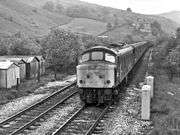British Rail Class 46
Derby Type 4
British Rail Class 46|

|
|
|
|
|
| Performance figures |
|---|
| Maximum speed |
90 mph (145 km/h) |
|---|
| Power output |
Engine: 2,500 bhp (1,864 kW)
At rail: 1,962 hp (1,463 kW) |
|---|
| Tractive effort |
Maximum: 55,000 lbf (245 kN) |
|---|
| Loco brakeforce |
63 long tons-force (628 kN) |
|---|
|
|
|
The British Rail Class 46 is a class of diesel locomotive. They were built from 1961-1963 at British Railways' Derby Works and were initially numbered D138-D193. With the arrival of TOPS they were renumbered to Class 46. Fifty-six locomotives were built. The first was withdrawn in 1977 and all of them were withdrawn by the end of 1984.
Overview
The Class 46 design was structurally the same as the preceding Class 45 build, and had the same Sulzer engine, but differed in the fitment of a Brush generator and traction motors, in place of the Crompton Parkinson equipment fitted to the Class 45. Along with the other Sulzer class 44 and 45 designs they are often referred to as "Peaks", so named because the earliest of the Class 44 were named after mountains.[1][2]
Operation
Despite intermittent use on freight trains, Class 46s were regular performers on passenger turns, particularly North East-South West, Trans-Pennine and secondary North East-London trains,[2][3] and depot allocations reflected this with locos at Gateshead, Cardiff and Plymouth in 1977[4] giving a typical spread. Freight workings were also quite often worked over long distances, particularly "clay hoods" carrying china clay from Cornwall to the area around Stoke-on-Trent.
In the 1980s the remaining locomotives were concentrated at Gateshead depot, and the final booked passenger workings for the class were the dated summer Saturday services Bradford - Weymouth (between Bradford and Birmingham New Street), Newcastle - Plymouth, Newcastle - Blackpool North, and York - Blackpool North.[5]
Nuclear flask crash test

The test at Old Dalby
On 17 July 1984, 46009, hauling three Mark 1 coaches, was deliberately crashed into a "Flatrol" wagon loaded with a nuclear waste flask and lying on its side. The train was travelling at about 100 mph (160 km/h) on the Old Dalby Test Track in a test organised by the CEGB.[6][7][8] The test was intended to demonstrate to the public that there would be no leak of radioactive material in the event of a rail accident involving a train carrying a nuclear waste flask.[6][9]
46009 was scrapped on site at Old Dalby later the same month by Vic Berry of Leicester. Images
Preservation
Three have been preserved: 46010 at the Great Central Railway; 46035 Ixion; and D182 (46045) at Midland Railway - Butterley
Gallery
| 46037 at Manchester Victoria (1983) |
| Preserved loco D182 at Grosmont (May 2008) |
|
References
- ↑ "Peak to be sold". Railways Illustrated: 36. November 2007.
- 1 2 Montague, Keith (1978). The Power of the Peaks. Oxford: Oxford Publishing Co. ISBN 0-902888-99-4.
- ↑ Lund, E (1980). To the last drop. Chesterfield: Longden technical Publications. ISBN 0-9507063-0-2.
- ↑ British Rail Locoshed Book 1981. Shepperton: Ian Allen Ltd. ISBN 0-7110-1112-5.
- ↑ Webster, Neil; Greaves, Simon; Greengrass, Robert. Loco-hauled travel 1984-5. York: Metro Enterprises Ltd. ISBN 0-947773-00-2.
- 1 2 Slater, John, ed. (October 1984). "Operation 'Smash Hit'". Railway Magazine. Vol. 130 no. 1002. Sutton, Surrey: Transport Press. pp. 394–5.
- ↑ Dowler, H. J.; Molyneaux, T. C. K.; Miles, J. C. (1987). "Analysis of the forces on a nuclear fuel transport flask in an impact by a train" (PDF). Proceedings of the Institution of Mechanical Engineers, Part A: Power and Process Engineering 1983-1988 (vols 197-202). 201 (11): 55. doi:10.1243/PIME_PROC_1987_201_007_02.
- ↑ Coxon, Dave, "CEGB staged collision with Nuclear flask 1985", www.old-dalby.com
- ↑ "Nuclear Flask Train Crash Test - BBC News 1984". www.youtube.com. BBC.
Sources
- Webb, Brian (1978). Sulzer Diesel Locomotives of British Rail. Newton abbott: David & Charles. ISBN 0-7153-7514-8.
Further reading
External links
British railway locomotives and miscellany, 1948 to present |
|---|
|
| Diesel shunters | |
|---|
|
Diesel shunters
(pre-TOPS) | |
|---|
|
| Main-line diesels: | |
|---|
|
Main-line diesels
(pre-TOPS) | |
|---|
|
| Electrics | |
|---|
|
Electrics
(pre-TOPS) | |
|---|
|
| Departmental | |
|---|
|
| Prototypes | |
|---|
|
| Steam locomotives | |
|---|
|
| Ships | |
|---|
|
|




